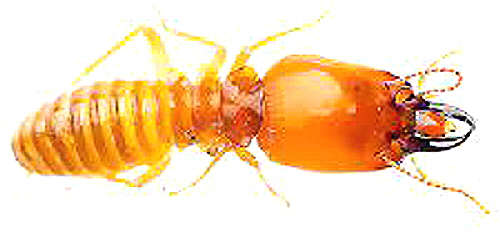It all started when my wife casually asked, “What’s this pile of dirt in here?” as she was cleaning out one of the lockers on Britannia. It certainly looked like dry dirt, a mound about 9” inches long and 3” inches wide, but when I poked it with a long screwdriver a lot of little white beetles started running around from inside. “Oh my God!” I exclaimed, “I think they're termites!” Actually that was not exactly the wording I used, but its all that is printable here. In termite terminology we had discovered a “carton,” which is a strange name for a mound of insects. Termites are not very big: a little bit over 1/8th of an inch long, but what they lack in size they make up for in numbers and I had disturbed plenty of them in this carton.
After we had calmed down with a cup of tea I began to research termites on the web and within half an hour we knew we had a problem. Coptotermes Formosanus is the posh name for Formosan termites, that are in the same family as Subterranean termites that infest houses. The difference is that Formosans have evolved to live in wood without the need to return to the ground for moisture, like their Subterranean cousins. They all eat cellulose that is fou
nd in wood, and they are voracious brutes that have been known to sink wooden ships. They have pincers that act a bit like garden shear, but luckily they cannot knore though fibreglass, so we had no fear of sinking. This discovery started an urgent exploration of nearby woodwork and lockers where we were able to follow clearly defined tracks on the plywood called tunnels.
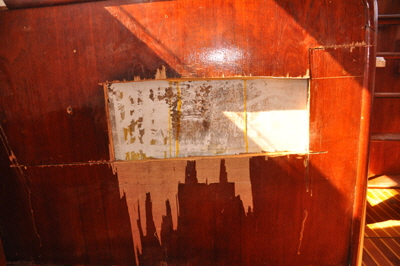 We could even see the little blighters running backwards and forwards along open edges of plywood that continued for some ten feet from the original carton. Occasionally we found smaller mounds hidden behind bulkheads. I discovered a large number of them in the foam insulation round the freezer box, that I stripped out completely and disposed of.
We could even see the little blighters running backwards and forwards along open edges of plywood that continued for some ten feet from the original carton. Occasionally we found smaller mounds hidden behind bulkheads. I discovered a large number of them in the foam insulation round the freezer box, that I stripped out completely and disposed of.
We learned they are communal insects, having a hierarchy of soldiers, workers, nymphs (newborns), and a single queen all within a carton. They would have to be communal, because who else would love a termite except another termite? Once a year they ‘swarm” by growing wings and flying somewhere else to start another colony. “Not on my damn boat they don't! I hadn't grafted like a termite for five years on Britannia, only to have it eaten by a bunch of ferocious bugs!
One of the things I was interested in was how long they had been in the boat, and where they might have come from. This was answered by Dr. Rudolf H Scheffrahn, Professor of Entomology & Nematology at Fort Lauderdale Research and Education Center. Florida. Apparently termites are endemic in the Deep South and no more so than in Florida, hence their name. The epicenter where the most reportings occur on boats is at Fort Lauderdale, and guess where I bought my boat? That’s right, Fort Lauderdale! I don't know if they were on the boat when I bought it because the surveyor didn't say anything about them, but I would strongly urge anyone buying a used boat in that area to have a detailed termite inspection before purchase. It can turn out to be expensive.
I also learned there was only one certain way to get rid of them on a boat, or a house for that matter. This is by pumping a highly toxic gas into the inside that effectively suffocates any living thing, including as a sort-of bonus, roaches, spiders and ants.
The vessel first has to be sealed to stop the pressurized gas escaping, and this can be done in two ways. In a house the whole building is usually “tented,” which means covering it with tarpaulins over the roof down to the ground. This method can also be employed on power boats that don't have masts or the multitude of rigging like a sailboat. A sailboat is usually “taped and sealed,” using masking tape to seal all outlets including access to hollow aluminum masts and any other outside vents. After the boat is completely sealed the gas, sulfuryl fluoride is pumped in at about two pounds per minute, but this is determined by factors like the outside temperature and the inside volume of the boat. It is then monitored for some hours and fresh gas injected if the pressure drops due to leakage.
The gas is clear, has no smell and is non-inflammable, but highly viscose and permeates everywhere where there are holes and the smallest nook and cranny and termite tunnels. It is further distributed by fans placed inside the boat to distribute the gas to all corners of the inside and effectively suffocates all air breathing organisms. This process continues for about six hours, and is then left for 24 hours, after which the tapes are removed and the boat is opened up to completely ventilate the inside. The gas leaves no residue or smell and the inside is safe after about six hours of open ventilation.
FINDING AN EXTERMINATOR.
I had a very frustrating time trying to find a fumigation company in my area of central east Florida. Not all pest control people deal with termites, and those that do sub-contract the job to even fewer actual operators. I finished up interviewing five different companies whose representatives came to the boat and spouted off in varying degrees of exactitude about how good they were. One major pest company sent a woman who, as I helped her step aboard exclaimed that she had never been on a sailboat in her life. That gave me a lot of confidence.
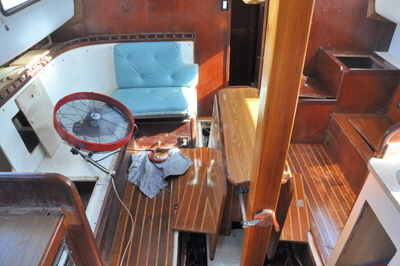 I received a verbal quote of $1350 from a local company, but when I didn't receive their contract after a week I called, and called, and called, and never did hear back from them. I received a quote from a national pest control company of $4,000, but they wanted the boat on the hard so they could “tent it.” That would cost another $500 to lift her. How they would tent a schooner with all its rigging I asked? The representative didn't actually know because he had never done one before. Over a period of a month I saw another couple of operators who came to inspect the boat and promised to send a quote. I heard nothing further from any of them. In the meantime the offending bugs has been chewing and chewing...
I received a verbal quote of $1350 from a local company, but when I didn't receive their contract after a week I called, and called, and called, and never did hear back from them. I received a quote from a national pest control company of $4,000, but they wanted the boat on the hard so they could “tent it.” That would cost another $500 to lift her. How they would tent a schooner with all its rigging I asked? The representative didn't actually know because he had never done one before. Over a period of a month I saw another couple of operators who came to inspect the boat and promised to send a quote. I heard nothing further from any of them. In the meantime the offending bugs has been chewing and chewing...
This was very frustrating and I just couldn't understand the sense of someone coming to the boat, spending an hour bragging about how good they were, then never contacting me again. By this time I knew more about the operation they they did. I learned that there were only a few actual operators in Florida, and they all used a gas called Vikane, made by Dow Chemicals, that is actually sulfuryl fluoride.
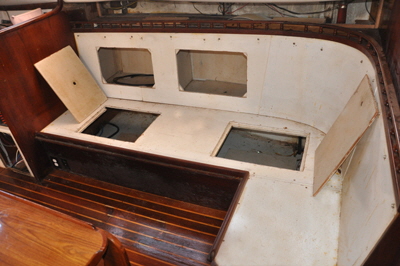 After posting another inquiry on the Cruising forum I found a company called Esystex in North Carolina, who actually make the gas under the trade name Zythor. They put me in touch with one of their major users, Fumeout Inc., in Fort Pierce, Florida, who specialize in fumigating boats. I spoke to Jackie Valencia the owner, who told me they were very familiar with Formosan Termites on boats, and indeed they have a picture of a boat being “tented” on their website, www.Fumeout.com. Jackie quoted me $1580.00 to tape and seal Britannia, and she didn't even need to come and inspect the boat, she knew what a schooner looked like. Finally I had found my operator, and a deal was struck. They could do the job in a week.
After posting another inquiry on the Cruising forum I found a company called Esystex in North Carolina, who actually make the gas under the trade name Zythor. They put me in touch with one of their major users, Fumeout Inc., in Fort Pierce, Florida, who specialize in fumigating boats. I spoke to Jackie Valencia the owner, who told me they were very familiar with Formosan Termites on boats, and indeed they have a picture of a boat being “tented” on their website, www.Fumeout.com. Jackie quoted me $1580.00 to tape and seal Britannia, and she didn't even need to come and inspect the boat, she knew what a schooner looked like. Finally I had found my operator, and a deal was struck. They could do the job in a week.
DEATH TO TERMITES DAY. (DT Day).
We spent four days clearing out the boat, even though I was told it was not necessary to move anything except food. But I wanted to give the gas the easiest possible route to every remote corner.
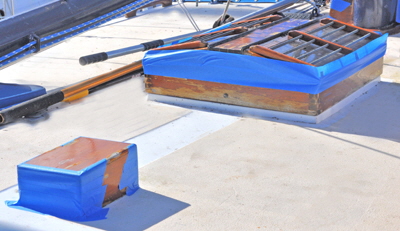 We removed all the soft cushions and bunk mattresses, and lifted the many panels under bunks and seats. I also removed many of the locker doors to give better circulation and one section of a bulkhead that was obviously infected. I even shifted all the bow and stern anchor chain out of the lockers to allow the gas to permeate into the chain lockers. All this took three van loads of equipment back to my home, and my garage began to look like a chandlers shop.
We removed all the soft cushions and bunk mattresses, and lifted the many panels under bunks and seats. I also removed many of the locker doors to give better circulation and one section of a bulkhead that was obviously infected. I even shifted all the bow and stern anchor chain out of the lockers to allow the gas to permeate into the chain lockers. All this took three van loads of equipment back to my home, and my garage began to look like a chandlers shop.
A team of four arrived on the appointed day and the foreman made a quick inspection of the boat. I showed him the various outlets that I thought needed sealing, like the bilge vents, Dorade vents, and where wires lead into the base of the masts. It took about an hour to tape and seal all these possible leakage points.
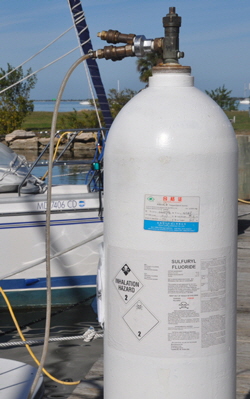
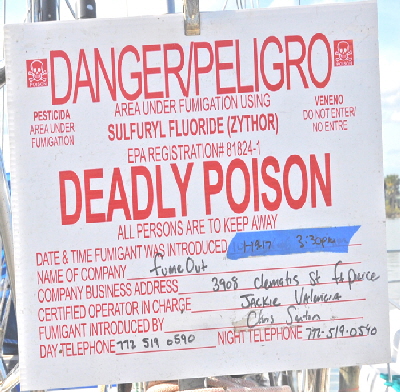 The gas was in a five foot high heavy container that stood on the dock, like a soldier waiting to do his deadly work. The gas valve was opened and the timing began as a warning notice was clipped to the pulpit. This notice was certainly to the point, and I wondered if it might detour intruders if we left the boat for any length of time, gas or no gas? It only took ten minutes to inject the gas, which I thought was a bit of a let down but it certainly indicated the toxicity of the stuff. I even half pitied the termites who were no doubt getting the shock of their lives at this moment. I did say half pitied.
The gas was in a five foot high heavy container that stood on the dock, like a soldier waiting to do his deadly work. The gas valve was opened and the timing began as a warning notice was clipped to the pulpit. This notice was certainly to the point, and I wondered if it might detour intruders if we left the boat for any length of time, gas or no gas? It only took ten minutes to inject the gas, which I thought was a bit of a let down but it certainly indicated the toxicity of the stuff. I even half pitied the termites who were no doubt getting the shock of their lives at this moment. I did say half pitied.
My wife and I then left the boat to await the all clear that we were told should be the next day all being well. The telephone call did indeed come from Jackie, who is the person licensed to authorize the completion of the process, to say we could return to the boat any time we liked.
I asked how she knew the deed was done, since presumably the termites that had been treated inside plywood wouldn't have come running out with their hands up? She said she used an expensive instrument called a Termatrac Ti, that is placed on the face of the wood and registers even microscopic traces of activity within timber.
We returned the following day to find the boat just the same as we had left it inside and out. There was no hint of an odor or any sign of residue and no sign of any dead termites or any other bugs. It then took four days to return all the equipment to Britannia, but eventually we got back to normal, and six months later we still haven't seen any dead bugs. It's almost as if it was all a dream, except for the hole in our bank statement.
